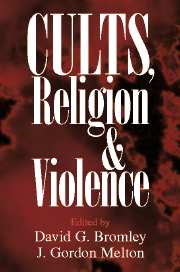Book contents
- Frontmatter
- Contents
- Acknowledgments
- Contributors
- Prologue
- 1 Violence and Religion in Perspective
- 2 Dramatic Denouements
- 3 Challenging Misconceptions about the New Religions–Violence Connection
- 4 Sources of Volatility in Religious Movements
- 5 Crises of Charismatic Legitimacy and Violent Behavior in New Religious Movements
- 6 Public Agency Involvement in Government–Religious Movement Confrontations
- 7 Watching for Violence: A Comparative Analysis of the Roles of Five Types of Cult-Watching Groups
- 8 Mass Suicide and the Branch Davidians
- 9 Occult Masters and the Temple of Doom: The Fiery End of the Solar Temple
- 10 Dramatic Confrontations: Aum Shinrikyô against the World
- 11 Making Sense of the Heaven's Gate Suicides
- 12 Lessons from the Past, Perspective for the Future
- Index
- References
7 - Watching for Violence: A Comparative Analysis of the Roles of Five Types of Cult-Watching Groups
Published online by Cambridge University Press: 09 July 2009
- Frontmatter
- Contents
- Acknowledgments
- Contributors
- Prologue
- 1 Violence and Religion in Perspective
- 2 Dramatic Denouements
- 3 Challenging Misconceptions about the New Religions–Violence Connection
- 4 Sources of Volatility in Religious Movements
- 5 Crises of Charismatic Legitimacy and Violent Behavior in New Religious Movements
- 6 Public Agency Involvement in Government–Religious Movement Confrontations
- 7 Watching for Violence: A Comparative Analysis of the Roles of Five Types of Cult-Watching Groups
- 8 Mass Suicide and the Branch Davidians
- 9 Occult Masters and the Temple of Doom: The Fiery End of the Solar Temple
- 10 Dramatic Confrontations: Aum Shinrikyô against the World
- 11 Making Sense of the Heaven's Gate Suicides
- 12 Lessons from the Past, Perspective for the Future
- Index
- References
Summary
Cults and violence are commonly bound inextricably together in the public mind. There have, after all, been some horrifying testimonies to their connection in the recent past: the murders and mass suicide of Jim Jones's Peoples Temple and the Solar Temple; the terrifying siege at Waco, which ended with the fire that killed the children trapped in the compound along with David Koresh and his followers; and, perhaps most ominous of all, the poisoning of innocent travellers on the Tokyo underground by members of Aum Shinrikyô.
Undoubtedly these tragedies would not have occurred had the movements not existed and carried out the actions that they did, but the actions did not take place in a vacuum. All of them, and even the Heaven's Gate suicides, were part of a “cult scene” that includes other members of the wider society – and among the key players in the “cult scene” are the cult-watching groups (CWGs). These are organisations and networks of people who, for personal or professional reasons, contribute to the complex of relationships between new religious movements (NRMs) and the rest of society.
There are those who argue that, were it not for the existence of CWGs acting as ever-vigilant watchdogs, there would be far more violence than there has been. There are also those who argue that it is some of the CWGs themselves that have contributed to what violence there has been through their aggressive attacks on the movements, exacerbating rather than ameliorating the situation.
- Type
- Chapter
- Information
- Cults, Religion, and Violence , pp. 123 - 148Publisher: Cambridge University PressPrint publication year: 2002
References
- 5
- Cited by



